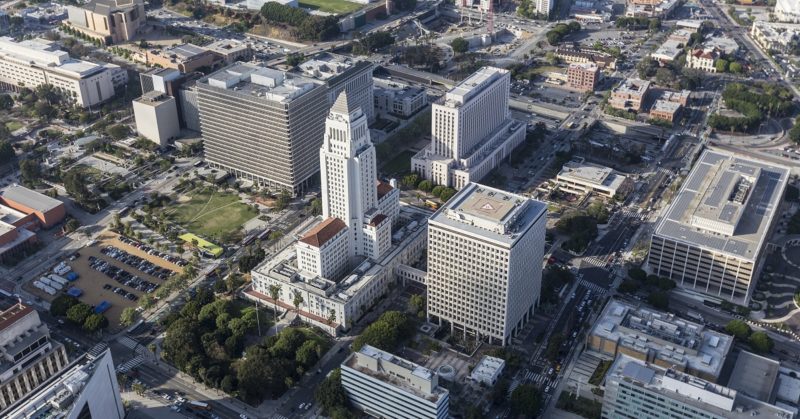The City of Los Angeles will use the alternative delivery method of Design-Build-Finance-Operate-Maintain (DBFOM) to deliver the Los Angeles Street Civic Building.
This major project is located at the site of the former Parker Center, which was at the center of many historical and often controversial real-life stories and served as a backdrop and stage for many television shows and movies.
Demolition of Parker Center is scheduled to begin in late 2018, ending by December 30, 2019.
The Civic Building will be a 27- to 29-story, 753,740-square-foot high-rise with a maximum height envelope of 450 feet and underground parking for 1,173 vehicles. It will include offices, commercial spaces, and a child-care facility. (There is currently a child-care facility in City Hall East. There is no mention in the City documents as to whether that child-care facility will close when the new facility opens in 2023.)
The report recommending DBFOM as the delivery method for the building analyzed three primary project methods: Design-Bid-Build, Design-Build and nontraditional Public-Private Partnership options, including Non-Profit Design-Build-Finance with Long-Term Operations and Maintenance, and DBFOM.
The report states DBFOM is preferred because:
- Delivery is likely to be faster than the other options as it takes advantage of a consolidated team of private sector staff support. Using DBFOM, current projections call for the building to be completed by March 2023, as compared to the Design-Bid-Build option with completion in June 2024 or the Design-Build option with completion in December 2023.
- The scope and total cost for design, construction, and maintenance for 30 years can be established in approximately 1.5 years, much sooner than with the other delivery options, and with an upfront investment on the city’s part of approximately $8.1 million.
- The development can be structured so that the city only starts payments to the development team when the city occupies the new building.
- After 30 years of operation, the DBFOM option will allow the building to be returned to the city with an 80 percent to 85 percent residual value, a term that can be included as part of the project development.
- Construction market risks and building operations and maintenance risks are mitigated by an upfront, comprehensive development agreement.
The project costs are not considered a city debt obligation, thereby retaining debt capacity for other city obligations.
The report cautions that under a DBFOM agreement, the city will not be able to use the building as an asset for capital purposes and will not be able to defer maintenance costs in times of financial stress. (One of the City’s go-to tools when there is a budget deficit is to defer operations and maintenance costs on its infrastructure.)
The report also states that since DBFOM is a new delivery mechanism for Los Angeles, there will most likely be a learning curve. In conjunction with this, legal knowledge regarding DBFOM contracts is limited in the city. To address this deficiency, city staff should be augmented with support from outside legal specialists.
The example given for having outside legal support is the Department of Airports’ recent completion of a DBFOM contract award for the “people mover” project. From a lay person’s point of view, I do not think this is an apples-to-apples comparison since I see little similarity between a “people mover” project and a skyscraper.
The report also includes the total budget for the Parker Center demolition, pre-design of the Civic Building, and the city staffing needs for this project for more than $32 million. There are 11 city staff currently assigned to this project.
At this point, the Council has instructed the City Attorney to draft an ordinance to allow sealed, competitive bids for the project. The city plans to issue a request for qualifications to identify development consortia sufficiently qualified to deliver the overall project goals and requirements. The city will then shortlist the three to four most qualified teams.
After this phase, the city will issue a request for proposal to the short-listed teams to select its development partner. The request for proposal will be a “hardbid” proposal that will include project preliminary designs and specifications, full financing plans with equity/ lender commitments, fixed-price and date-certain construction bids, and fixed-price operations and maintenance bids, including lifecycle maintenance for 30 years. The contract will be awarded based on the “overall best value.”
To date, city consultants on this project have been IBI, Cummings, and Ernst and Young. The report from the City Administrative Officer to the Council and Mayor recommending DBFOM was done by Ernst and Young with the executive summary prepared by the City Administrative Officer and the Bureau of Engineering.
On some of the related documents, it appears that IBI was working with the city on the Environmental Impact Report for this project as far back as 2009. In addition, IBI did the preliminary design work on the demolition of Parker Center. (It’s interesting to note that in city reports regarding this project, Ernst and Young has been changed to Ernst and Young, Infrastructure Advisors.)
It’s unfortunate that Los Angeles chose DBFOM, which is the least transparent delivery method for the project, and which will be a central piece in the city’s Civic Center Master Plan.
It’s also disturbing because it allows non-construction focused businesses, such as consulting and accounting companies, to use public-private partnership delivery methods to make inroads into our industry.


